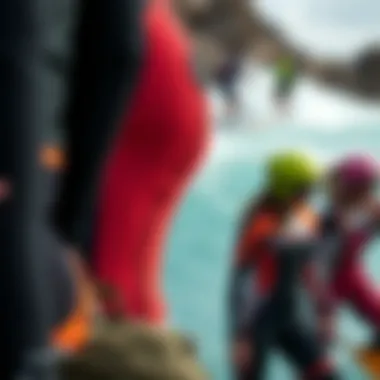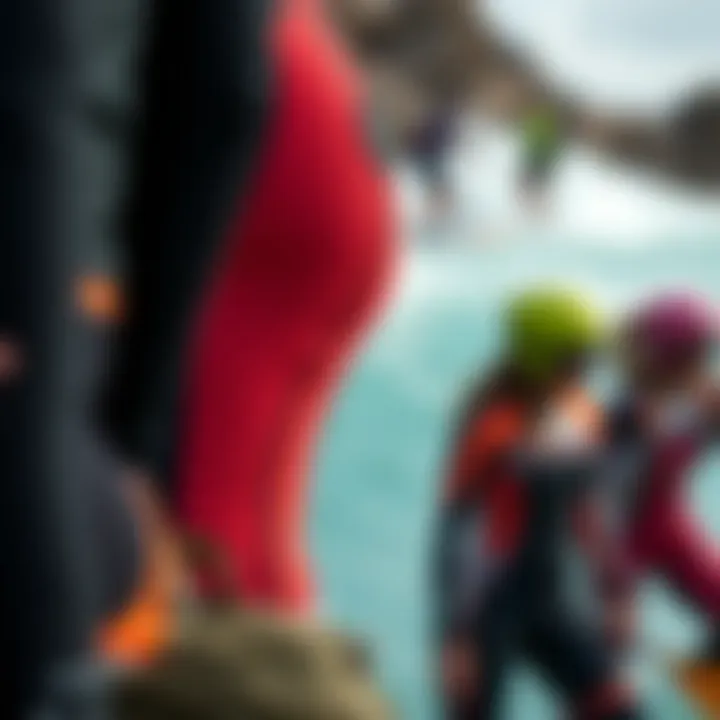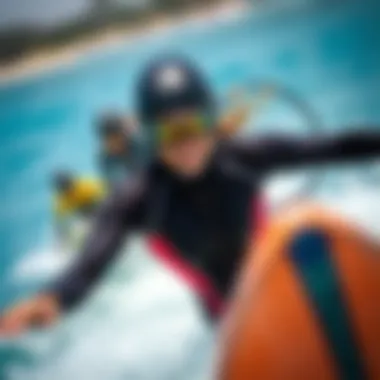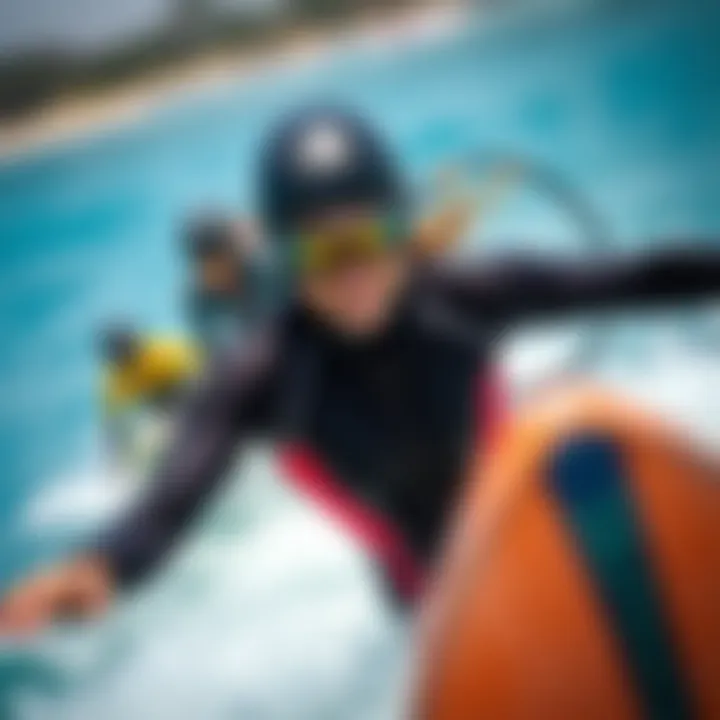Wetsuits for Tall Women: A Comprehensive Guide


Intro
Finding the right wetsuit can feel like searching for a needle in a haystack, particularly for tall women. With the unique challenges that height brings, it's essential to navigate through the seas of sizing, materials, and brands that cater specifically to slender frames with long limbs. In a world where gear is often designed with an average body type in mind, knowing where to look and what to consider can make all the difference in achieving comfort and functionality while kiteboarding or surfing. This guide is aimed at tall female athletes who are determined to maximize their performance in water sports, ultimately enhancing their experience.
Choosing a wetsuit doesn't just reflect on your physical appearance; it plays a critical role in how well you perform. Whether you're charging through the waves on a surfboard or gliding over the ocean while kiteboarding, the right fit will ensure that you are agile and comfortable, leading to better control and less fatigue.
In the sections that follow, we will take a closer look at the aspects of wetsuit selection that particularly benefit tall women, focusing on the right gear, techniques, and tips that can elevate your water sports experience. We'll tackle common sizing challenges, review materials that matter, and compare brands that pride themselves on inclusivity and functionality. It's high time to dive into the details.
Understanding Wetsuit Essentials
When it comes to selecting the right wetsuit, understanding the essentials is crucial, especially for tall women whose body proportions can complicate fitting. A wetsuit isn’t just another piece of gear; it's your second skin in the water, meant to keep you warm while allowing for freedom of movement. Knowing what a wetsuit is, how it functions, and its purpose in various water sports sets the stage for making informed choices that can enhance your aquatic experiences.
What is a Wetsuit?
A wetsuit is a layered garment made of neoprene, designed to provide thermal protection while you engage in water-based activities. The material works by trapping a thin layer of water between your skin and the suit, and as your body warms this water, it creates insulation. There are various types of wetsuits—full suits, shorties, and separates—each serving different purposes depending on the conditions.
For tall women, the nuance in wetsuit design comes into play. Not all wetsuits are made equal; fit varies significantly from brand to brand. A properly fitting wetsuit should feel snug without restricting movement. If the suit is too loose, it might let in cold water, negating its insulation properties. Conversely, an overly tight wetsuit can hamper circulation and hinder performance.
Purpose of Wetsuits in Water Sports
The primary purpose of wetsuits is protection against environmental elements such as cold water, sun exposure, and abrasions. For kiteboarders and surfers, staying warm is essential for both comfort and performance.
- Thermal Insulation: In cooler waters, a wetsuit serves as a barrier that keeps your body heat from escaping too quickly, which is vital for prolonged enjoyment and safety in water sports.
- Buoyancy: The buoyant properties of neoprene assist in flotation, reducing fatigue as you paddle or glide on waves.
- Protection from Elements: Besides warmth, wetsuits shield your skin from UV rays, jellyfish stings, and other hazards you might encounter in the water.
"A good wetsuit is like a trusty companion; it supports you, keeps you warm, and enhances your performance on water."
In summary, understanding what a wetsuit is and its role in water sports cannot be overstated. For tall women, this knowledge is integral as you navigate the challenges of fit and comfort, ultimately leading you to make the best choices for your water adventures.
Challenges for Tall Women in Wetsuit Selection
Selecting the right wetsuit can feel like navigating a labyrinth for tall women. As they brace for aquatic adventures, they often face a unique set of hurdles that others might not understand. The importance of addressing these challenges cannot be overstated—finding a fitting wetsuit significantly impacts both comfort and performance in water sports. From sizing discrepancies to understanding body proportions, tall women should embrace the factors that play into their wetsuit selection. Ultimately, a well-fitted wetsuit can enhance experience on the waves, making it worth the extra effort.
Understanding Body Proportions
When it comes to choosing a wetsuit, tall women frequently encounter complications due to their unique body proportions. Tallness doesn't automatically correlate with a specific size; it can also shift torso length, inseam, and sleeve length—all of which are critical in achieving a snug yet flexible wear. A wetsuit that fits well in one area might leave another needing adjustment. For instance, a suit that accommodates long legs might pull snug on the torso, leading to discomfort.
Understanding one’s body proportions requires taking specific measurements:
- Torso Length: Measure from the high point of your shoulder, down to the crotch. This helps in ensuring the suit doesn't over-pull when you’re paddling.
- Inseam Measurement: It’s essential to note how long this is, as it affects the fit around the legs.
- Sleeve Length: Measure from the shoulder to the wrist to avoid sleeves that are too short, which can cool you down quickly in the water.
Awareness of these different dimensions helps women choose a wetsuit that doesn’t just fit but complements their shape, allowing for ease of movement and comfort.
Sizing Inconsistencies Across Brands
Adding to the complexity of finding the right wetsuit, sizing inconsistencies among different brands can leave tall women feeling perplexed and frustrated. Unlike streetwear, wetsuits often have varied sizing charts, even if the labels appear similar. A size medium from one brand may feel completely different than the same size from another brand. It’s almost like trying to fit a round peg into a square hole—it just doesn’t mesh.
Some brands might lean towards a more fitted style while others may offer a roomier option, making it tough to gauge the right fit simply based on a number. To sidestep dissatisfaction, here are a few strategies:
- Review Size Charts: Always check the specific size charts provided by the manufacturer. These will often include height and weight recommendations alongside measurements.
- Consider Customer Reviews: Feedback from other tall women can provide insight into how sizing runs for specific wetsuits. They often share whether the suit fits as expected or if it runs small or large.
- Tailored Resources: Websites like SwimOutlet or Wetsuit Warehouse often carry a plethora of customer reviews and detailed sizing guides.
By acknowledging these hidden quirks in sizing, tall women can navigate the wetsuit selection process with a little more clarity, ultimately finding a suit that feels tailored even if it isn’t custom-made.
"The right fit in the water translates to confidence above the water—don’t settle for less."
Choosing the Right Wetsuit Size
Finding a wetsuit that fits well is crucial to enjoying your time in the water, especially for tall women. A good fit allows for better mobility, warmth, and overall comfort in various water sports, be it kiteboarding or surfing. If your wetsuit is too tight, it can restrict movement and cause discomfort, while a loose fit may lead to water pooling inside, which can make you feel cold and heavy. Hence, knowing how to choose the right size is paramount.
How to Measure Yourself


To kick things off, you need to measure your body accurately. Here’s how you can go about it:
- Height: Stand straight against a wall without shoes. Get someone to measure from the top of your head down to your feet. It’s not rocket science but getting a level measurement will help.
- Chest: Measure just under your armpits, making sure that the tape measure is snug but not too tight. Breathe normally; you want to avoid the ol’ cheese curds look.
- Waist: Measure around your natural waistline, usually an inch or two above your belly button.
- Hips: When measuring your hips, stand with your feet together and wrap the measuring tape around the widest part of your hips.
- Inseam: This is particularly important if you’re buying a full suit. Measure from your groin down to your ankle bone.
These measurements will serve as the foundation for selecting the right size when you look at size charts from various brands.
Interpreting Size Charts
Different brands can have different size charts, which may cause a bit of confusion at first. Here’s how to make sense of it all:
- Refer to Brand Size Guides: Check out the brand’s official size chart. Most brands will have these available on their websites. Don’t just assume that a size large from one brand is the same as another.
- Compare Your Measurements: Match your measurements from the previous section against the brand’s chart. If you fall between two sizes, lean toward the larger size if you have broader shoulders or a long torso.
- Check Reviews: Sometimes, previous buyers share insights about the sizing. Reviews can provide anecdotal evidence about whether their sizing runs small, large, or true to the chart.
- Consider the Wetsuit Style: Different styles of wetsuits (like shorties, semidry, or drysuits) might fit differently. Always consider the intended use—surfing might require a snugger fit compared to kiteboarding where mobility is more crucial.
Tip: Be aware of the stretching factor of neoprene. Neoprene will stretch slightly when worn, so if you’re on the fence about sizes, it’s fine to choose one that is slightly snug when dry.
Proper sizing isn't just about comfort; it's about ensuring that you can perform your best while participating in your beloved water sports. Remember to keep these measurements and guidelines handy when you go shopping for your wetsuit.
Wetsuit Materials and Their Functionality
When it comes to selecting a wetsuit, understanding the materials that make up these essential garments can be the difference between a comfortable day on the waves and an uncomfortable experience that cuts your adventure short. Wetsuits are crafted from specific materials designed to offer warmth, protection, and flexibility. Each component plays a critical role in ensuring that tall women, who may face unique challenges in sizing and fit, have a wetsuit that performs well in aquatic environments. Therefore, knowing how various materials function can empower taller athletes to choose a wetsuit that not only accommodates their height but also enhances their performance in water sports.
Neoprene Types Explained
Neoprene is the primary material used in wetsuits and for good reason. Its insulation properties are unmatched, making it the go-to choice for water sports enthusiasts. However, not all neoprene is created equal. There are several types, each catering to different needs:
- Standard Neoprene: The most common type, providing decent insulation while being relatively affordable. Ideal for beginners or those not frequently in cold water.
- Ultra-Stretch Neoprene: This variation offers enhanced flexibility and a snug fit, allowing for greater freedom of movement. It’s usually favored by surfers or kiteboarders who need to navigate quickly and fluidly.
- Eco-friendly Neoprene: As sustainability concerns rise, some brands are producing wetsuits made from limestone-based neoprene, which reduces the environmental impact. These suits still provide excellent thermal protection while championing eco-friendly practices.
- Textured Neoprene: This type features a unique surface to reduce drag in the water. It can help improve speed, making it a popular choice among competitive athletes.
By considering these neoprene varieties, tall women can find a wetsuit that not only fits their body but also suits their water activity. A well-chosen neoprene type enhances comfort, maintain warmth, and promotes performance.
Thickness and Cold Water Considerations
The thickness of the neoprene in a wetsuit is another critical factor, especially for tall women who may face seasonal water temperature changes. Wetsuits come in various thicknesses, typically measured in millimeters, and understanding what is best suited for different conditions is essential.
- 2mm: Great for warmer waters, usually seen in spring and summer. Not ideal for tall women in colder conditions, as the insulation may not be sufficient.
- 3mm: A versatile choice, offering protection in mildly cool waters. Suitable for fall and early spring, this thickness offers a practical balance between warmth and flexibility.
- 4mm and above: These are designed for colder environments. Tall athletes should ensure that a thicker wetsuit doesn’t compromise mobility, which can happen if it’s not well-fitted.
When selecting thickness, it’s crucial to consider how long you’ll be in the water, the specific temperatures you’ll encounter, and your personal tolerance to cold. Finding the right balance ensures you can enjoy your time in the water while avoiding the dreaded chill.
"Choosing a wetsuit is less about one-size-fits-all and more about understanding your own needs and the environment where you'll be diving in."
By paying attention to the materials and their functionalities, tall women can make informed decisions that enhance their experience in the water, whether they're kiteboarding, surfing, or simply enjoying the ocean's embrace.
Popular Wetsuit Brands for Tall Women
When it comes to finding the right wetsuit, especially for tall women, the brand can make a significant difference. Popular wetsuit brands not only offer a wide range of sizes and styles but also focus on the specific needs of taller athletes. This section aims to discuss the importance of selecting reputable brands known for catering to the unique shapes and sizes of tall women.
One key consideration is that leading brands often invest in research and development aimed at improving fit and functionality, which is vital for performance in water sports. Tall women frequently encounter challenges with traditional sizing approaches, making it essential to turn to brands that understand and commit to inclusivity.
Brand Comparisons: A Brief Overview
Understanding the landscape of wetsuit brands available today is crucial. Here’s a brief overview of some recognized names in the industry:
- O'Neill: Pioneering in the wetsuit market, O'Neill has developed a reputation for having excellent flexibility and comfort, ideal for surfing and kiteboarding. Their sizes often accommodate taller individuals better than some brands.
- Rip Curl: Known for their high-quality neoprene, Rip Curl offers a range of wetsuits designed for various water activities. They tend to focus on both performance and style, ensuring tall women have stylish options without sacrificing fit.
- Xcel: Xcel wetsuits are crafted with cutting-edge technology, designed for warmth and flexibility. They also provide size options that consider longer torso lengths, making them a solid choice for taller athletes.
- Quiksilver: Popular among surfers, Quiksilver offers a range of athletic-fit wetsuits that can accommodate taller frames. Their designs not only look good but also prioritize functionality and performance.
These brands stand out due to their commitment to quality and performance, but it's worth noting that each brand has its unique fit style. Therefore, it’s advisable to try different options to find what works best for you.
Top Recommendations for Tall Athletes
Finding the right wetsuit is not just about the brand; it’s also about the specific models that cater to taller women. Here are some top recommendations:
- O'Neill Psychotech Series: This model features a good length for taller women and durable seams, making it reliable for rigorous surfing or kiteboarding.
- Rip Curl Dawn Patrol: With a comfortable fit and high-quality materials, this wetsuit often receives praise for its extended torso length, which is ideal for taller body frames.
- Xcel Comp X: This wetsuit is known for being lightweight with exceptional flexibility. The design also includes extra long sleeves and legs, suitable for tall women.
- Quiksilver Syncro: Offering warmth and stretch, the Syncro is great for various water activities, especially if you're looking for something stylish yet functional.
In choosing a wetsuit, ensure that your selection aligns with both your body type and your planned water activity. Always refer to sizing charts provided by the brands, and when possible, try on different models to discover which fits best.


"Finding the right wetsuit can make all the difference in surpassing your limits in water sports."
For more information on wetsuit brands, you may refer to sources like Wikipedia or community discussions on Reddit.
Stay informed, comfortable, and ready to ride the waves!
Consequences of Poor Fit
Selecting the right wetsuit is not just about choosing the right size; it also significantly impacts performance and safety in water sports. A wetsuit that fits poorly can create a myriad of issues, from decreased agility to heightened risk of injury. This section sheds light on the key consequences of opting for an ill-fitting wetsuit, emphasizing why tall women should prioritize sizing and comfort.
Impact on Performance
An ill-fitting wetsuit can act as a real anchor when out on the water. When the suit is too baggy or tight, it interferes with movement, making it difficult to paddle or maneuver effectively. If a wetsuit is loose, water can seep in, creating drag and increasing weight. On the flip side, if it’s too snug, the constriction can inhibit flexibility.
Here are some performance aspects that can suffer due to poor fit:
- Reduced Mobility: A tight suit can restrict your range of motion. This is particularly challenging for tall women who often have longer limbs.
- Increased Drag: A loose-fitting wetsuit can trap water, decreasing speed and agility.
- Heat Retention Issues: Water trapped in the suit can cool quickly, causing body temperature to dip, which is a concern especially in colder waters.
"A proper fit is like the cherry on a sundae for performance. Without it, the whole experience can be soured," as one seasoned surfer aptly put it.
Risk of Injury and Discomfort
On top of performance issues, the potential for injury and discomfort rises dramatically with poor wetsuit fit. Chafing and skin irritation are notably common in misfitting suits, particularly in areas where the suit rubs against the skin, like underarms or the neck area.
Consider the following risks associated with an improper wetsuit fit:
- Chafing and Rashes: Constant friction against the skin can lead to painful abrasions, diverting focus away from enjoying the sport.
- Reduced Blood Circulation: A suit that's too tight can compress blood vessels, leading to numbing sensations, particularly in colder environments.
- Joint Strain: If your wetsuit doesn't provide proper support, it can impact your body's alignment. This can strain joints and lead to injuries over time.
In summary, the consequences of poor fit in a wetsuit extend far beyond mere comfort. For tall women involved in kiteboarding or surfing, ensuring a great fit not only enhances performance but also safeguards against injuries — allowing them to focus on riding the waves rather than dealing with discomfort.
As the saying goes, "The right tool for the job makes all the difference," and this holds especially true when it comes to the world of water sports. For more detailed insights into wetsuit fitting, visit Wikipedia’s guide on wetsuits or check out community discussions on Reddit.
Maintenance Tips for Longevity
Taking care of your wetsuit isn’t just an afterthought; it’s a crucial element in ensuring that your gear lasts as long as it can. Proper maintenance can mean the difference between a suit that performs well for many seasons and one that falls apart after just a few uses. For tall women, who may already face challenges in finding the right fit, this becomes even more critical. Treating your wetsuit with care enhances its durability and maintains its functionality, allowing you to enjoy your time in the water without worry.
Several factors play into how you maintain a wetsuit, including washing techniques and storage practices. Each one contributes significantly to the overall lifespan of the suit. By following these tips, you keep your wetsuit in optimal condition and ready for your next adventure, whether it’s kiteboarding or surfing.
Proper Washing Techniques
After each aquatic escapade, the immediate temptation might be to toss your wetsuit in the washing machine or leave it piled up wet in a corner. However, that’s not the best way to go about it. Here are some techniques to maximize the cleansing process:
- Rinse Immediately: As soon as you exit the water, rinse your wetsuit with fresh, cold water. This helps to remove salt, sand, and chlorine that can degrade the material. Make sure to rinse it inside out as well to clear any debris.
- Mild Detergent: If your suit is particularly dirty, use a wetsuit-specific shampoo or a mild detergent that does not contain harsh chemicals. Avoid regular laundry detergent at all costs, as they can break down the neoprene.
- Gentle Wash: When washing, do so gently. You don’t need to scrub vigorously; just let the cleaner do its work. Most suits can remain delicate enough that light contact will suffice.
- Dry Naturally: Never, ever put your wetsuit in the dryer. Let it air-dry away from direct sunlight. Hanging it up on a wide hanger helps prevent stretching.
Following these tips will help keep the neoprene elastic and prevent it from degrading over time, ensuring that your wetsuit remains a reliable companion in the water.
Storage Best Practices
Once your wetsuit is washed and dried, how you store it makes all the difference in its longevity. Improper storage can lead to creases, molds, and other issues that may arise from neglect. Here are some storage best practices:
- Hang it Up: Store your wetsuit by hanging it on a wider hanger. This encourages airflow and minimizes creasing, which is especially vital for tall women’s suits that need to retain their shape.
- Avoid Folding: Folding your wetsuit can create permanent creases that may weaken the material over time. Keep it hanging, straight and tidy.
- Cool, Dark Place: Store your wetsuit in a cool, dark area, avoiding moisture or heat sources like radiators or the trunk of a car. Molds and harmful bacteria love a warm, damp environment, and you don’t want to invite them in.
- Use a Wetsuit Bag: If you have the space and budget, consider a dedicated wetsuit bag. It can add another layer of protection from dust and dirt.
By maintaining your wetsuit and storing it properly, you enhance its performance and extend its life. This ensures that every thrilling ride on the water is backed by gear that fits well and stays dependable.
"Caring for your wetsuit is as important as choosing the right one; a little maintenance goes a long way."
Explore more about wetsuit care tips at Wikipedia and Britannica.
Custom Wetsuit Options
When it comes to selecting a wetsuit, many tall women find themselves facing a frustrating reality—off-the-rack options might just not cut it. This section delves into the significance of custom wetsuits, offering tailored solutions that consider the unique proportions of tall female athletes. Whether you’re surfing waves or kiteboarding through the skies, a well-fitted wetsuit can elevate your experience, both in terms of comfort and performance.
When to Consider Custom Fit


There are several factors that might prompt a tall woman to consider a custom fit for a wetsuit:
- Height and Body Shape: If standard wetsuits are consistently too short in the torso or tight in the shoulders, it’s time to think custom. Those stretchy materials may seem forgiving, yet a poor fit can impede movement.
- Specific Usage: For dedicated kiteboarders or surfers, the need for adaptability in various water conditions is paramount. A custom wetsuit tailored to your activity ensures you won't be limited by extra material or wrong sizing.
- Injuries and Sensitivities: Some women may have experienced discomfort or injuries linked to ill-fitting wetsuits. A custom fit allows for adjustments in regions prone to pressure or rubbing, leaving you focused on your craft rather than distractions.
- Durability: Custom wetsuits, though often priced higher, can provide lasting value. Precision in fit can lead to higher durability as they are made to accommodate individual body movements rather than a one-size-fits-all approach.
It's essential to weigh the benefits against standard options and recognize that a custom wetsuit often makes the difference between merely participating and truly enjoying your water sport.
Custom Wetsuit Services Overview
The world of custom wetsuits is more accessible than many might think. With technology and artisanship coexisting, many brands offer specialized services to craft wetsuits based on personal measurements and preferences. Here’s what to expect when diving into the custom wetsuit realm:
- Measurement Process: Most custom services will request detailed measurements. This generally includes height, weight, chest girth, waist size, hip width, and inseam. Some even provide guides to help ensure you get the measurements right, often suggesting taking several to confirm accuracy.
- Material Selection: Customized options often allow you to choose from a variety of materials. Different thicknesses and textures can be selected based on expected water temperatures and personal preference. Brands like O’Neill or Rip Curl might provide different choices to optimize performance and comfort.
- Design Features: Custom wetsuits can be tailored not just to fit your body but to suit your aesthetic preferences. Choose colors, patterns, and additional features like reinforced knees or extra padding in key areas.
- Lead Time and Cost: Expect the creation process to take some time—typically anywhere from a few weeks to a couple of months. Costs will vary significantly and can reach well into the hundreds, so planning ahead is prudent.
"Finding the right fit can redefine your relationship with water sports, encouraging you to push the limits."
While the journey to receive a tailor-made wetsuit may require patience, the enhanced comfort and performance are well worth the wait. Targeting your unique body type elevates your experience, letting you fully embrace the challenges and joys of water adventure.
For further reading on how custom wetsuits came to be and which brands excel in this niche market, you can explore resources like wetsuitreview.com or check user reviews on platforms such as reddit.com or facebook.com.
Environmental Considerations
In today’s world, where climate change and environmental protection are at the forefront of conversations, it’s vital for outdoor enthusiasts, especially tall women engaging in water sports, to consider the ecological impact of their equipment. Wetsuits are no exception. Understanding the environmental considerations when selecting wetsuits can lead to more sustainable choices and a lower carbon footprint.
The importance of choosing eco-friendly wetsuit options goes beyond just personal performance. It promotes a healthier planet, ensuring that the oceans and waterways, which serve as playgrounds for surfers and kiteboarders, remain pristine for future generations. This guide points out how adopting eco-conscious habits can align with a passion for water sports, creating a win-win situation.
Eco-friendly Wetsuit Options
When you think about wetsuits, the first thing to come to mind is probably not the materials and processes used to create them. However, eco-friendly options are becoming increasingly accessible and worth your attention. Traditional neoprene, often derived from petroleum, has been the standard in wetsuit manufacturing for ages, but this is changing.
Several brands now offer wetsuits made from alternative materials that are kinder to the environment. For example, limestone-based neoprene is one alternative that reduces carbon emissions during production. It is also less toxic and generally more flexible than typical petroleum-based neoprene. Here are some eco-friendly wetsuit options available:
- Yulex: This is a natural rubber sourced from rubber trees. It’s biodegradable and offers a good stretch and durability, making it ideal for various water activities.
- ECO-Certified Neoprene: Some companies use neoprene that has been certified by organizations that ensure lower environmental impact during production. Brands like Patagonia have taken steps in this direction.
- Recycled Materials: Some wetsuits are now crafted from recycled plastics and materials that have been diverted from landfills, land-made from post-consumer waste.
These options not only help reduce waste but also support a growing market that prioritizes sustainability.
Sustainable Practices in Manufacturing
The journey toward sustainability starts long before a wetsuit lands in a store. Manufacturing practices in the wetsuit industry have a significant role in minimizing environmental damage. Many companies are reevaluating their production processes to reduce water and energy usage and to lower harmful emissions.
Here are some sustainable practices to look out for when shopping for a wetsuit:
- Fair Labor Practices: Many brands are adopting ethical codes of conduct to ensure their workers are treated fairly and work in safe conditions.
- Water Conservation: By changing dyeing techniques, companies can significantly cut down on water waste. This can involve innovations like using closed-loop systems that recycle water in the dyeing process.
- Minimal Waste Production: Brands that prioritize zero-waste practices are making significant strides by cutting down on fabric waste during production. They may use software to optimize pattern designs and keep material usage efficient.
In a nutshell, choosing a wetsuit that reflects your values is just as important as fit and performance. When you opt for brands committed to sustainable manufacturing practices, you support a future where adventure can coexist with environmental stewardship.
By understanding the eco-friendly options available and supporting sustainable practices, tall women can play a critical role in the movement towards a more responsible and enjoyable water sports experience, truly embracing the spirit of adventure without sacrificing the planet.
Final Thoughts
Choosing the right wetsuit is no small feat, especially for tall women who often face unique challenges. This article has traversed various essential elements, from understanding the basic structure of wetsuits to the intricate details of custom options and environmental considerations. It underscores the harsh realities of poor fits; a wetsuit that doesn’t fit well can hinder performance and create discomfort while participating in water sports.
Furthermore, the guidance provided on measuring oneself and interpreting size charts adds a layer of empowerment. It encourages women to take charge of their own custom needs, rather than relying solely on generic sizing that often glosses over the nuances of a tall woman's unique body shape.
There’s also importance in considering eco-friendly options. As awareness of our environmental footprint increases, the sustainability of the materials in your wetsuit has become a priority for many. Opting for an eco-conscious wetsuit supports not only personal health but also the health of our oceans, which is a concept that resonates deeply with water sports enthusiasts.
In sum, being an adventurous woman doesn't have to come at the cost of comfort. Understanding the nuances in wetsuits allows for a more enjoyable experience, enabling you to focus on what matters—that exhilarating glide over water, catching waves, and soaking up nature. While the world of wetsuits may seem daunting, this guide aims to provide clarity and tips to help make informed decisions.
Key Takeaways for Tall Women Purchasing Wetsuits
- Know Your Measurements: Take time to accurately measure your body. Focus on chest, waist, hips, and inseam. This will help in selecting the right size.
- Understand Material Types: Different materials serve different purposes. For colder waters, thicker neoprene is advisable, while thinner options work great in warmer climates.
- Brand Diversity: Not all brands fit the same. Research brand-specific size charts and customer feedback to find the best fit for your shape.
- Custom Wetsuit Options: If general sizes don’t cut it, consider a custom wetsuit. They can address particular dimensions and offer tailored mobility—a fit designed just for you.
- Maintain Your Wetsuit: Proper care can prolong the life and functionality of your wetsuit. Rinse with fresh water after use, and store it in a cool, shady place.
"A well-fitted wetsuit is an extension of your body; the right one enhances performance, comfort, and enjoyment."
Encouragement for Continued Pursuit of Water Sports
As you step into the waves, remember that challenges in choosing the right wetsuit are simply stepping stones to embracing your passion for water sports. Don’t let sizing dilemmas deter you from enjoying the thrill of kiteboarding or surfing. Embrace your adventurous spirit, and remember that many tall women share your experience; thus, the right fit is out there.
By making informed choices, you not only become a better athlete but also pave the way for others to follow. Maybe you'll even inspire someone else who has shied away from the water because they didn't find good gear that fits them well. Keep pushing boundaries, exploring the waves, and expanding your skills in the water. Your journey is ours to celebrate.



